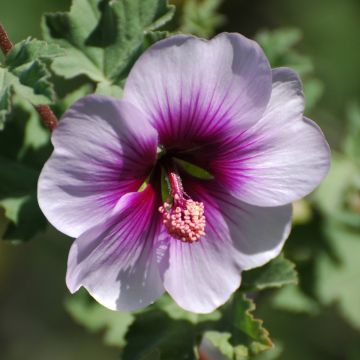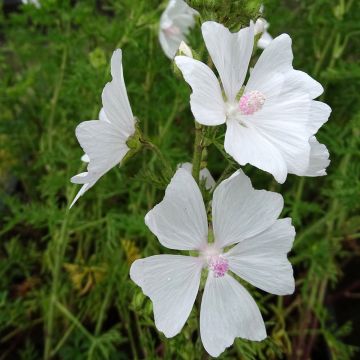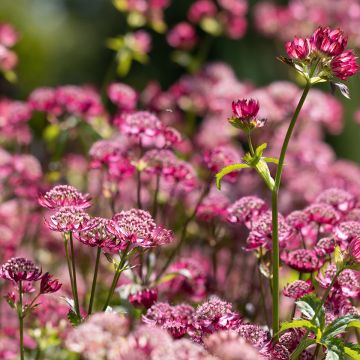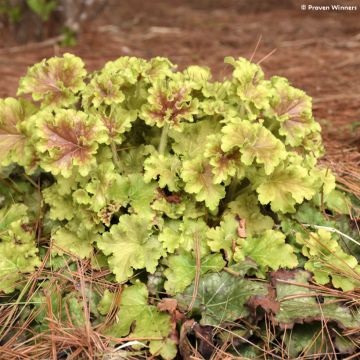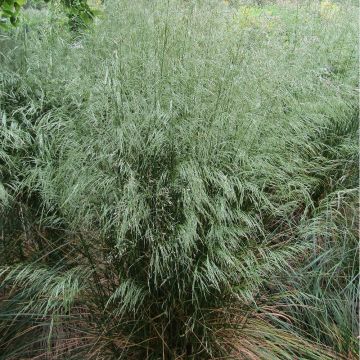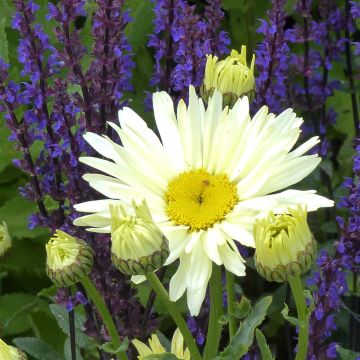

Lavatera Blue Bird - Lavatère arbustive
Lavatera Blue Bird - Tree Mallow
Lavatera Blue Bird
Tree Mallow
Why not try an alternative variety in stock?
View all →This plant carries a 12 months recovery warranty
More information
We guarantee the quality of our plants for a full growing cycle, and will replace at our expense any plant that fails to recover under normal climatic and planting conditions.
From €5.90 for pickup delivery and €6.90 for home delivery
Express home delivery from €8.90.
Delivery to Corse prohibited: UE law prohibits the import of this plant from mainland France to Corse as part of the fight against Xylella fastidiosa. Please accept our sincere apologies.
More information
Does this plant fit my garden?
Set up your Plantfit profile →
Description
Lavatera 'Blue Bird' is a new variety full of surprises; first of all, its hibiscus flowers display an astonishing hue for a bushy Lavatera, a light blue-mauve, delicately veined with darker violet. They bloom from summer to autumn if you take care to remove faded flowers. Flowers appear on the upper branches of the deciduous bush with green-grey foliage. This hardy variety can withstand temperatures down to -10°C/-12°C (10.4°F) and performs well in well-drained soil. Charming and radiant, it elegantly adorns the back of flower beds and can also be planted individually or in a pretty pot.
Lavateras belong to the large family Malvaceae. It is a genus that includes numerous species, some more woody than others which can be annual, biennial, or perennial. They originate from various temperate regions around the globe but are mainly found in Mediterranean climates.
The 'Blue Bird' variety is a recent shrubby hybrid originally from a French nursery. Half-perennial, half-shrub, this plant has a balanced, bushy, and round habit, reaching 1.5 metres (5 feet) in all directions. This abundant and generous small bush produces flowers measuring 5 to 8 cm (2 to 3in) in diameter, composed of five slightly separated and bilobed petals, which are an unusual pale blue-mauve shade and veined with violet, and slightly tinged with pink in the centre. These flowers are ephemeral but continuously renew from July to August, or even longer under good growing conditions. The abundant deciduous foliage is composed of palmately lobed, soft-to-the-touch leaves, forming a very soft ensemble in a grey-green shade.
Lavatera 'Blue Bird' is undeniably unique and refined, but its beauty will not overshadow that of any accompanying plants. It will look beautiful in a small informal hedge or in a shrub bed with yellow flowering plants or foliage plants that will enhance it (Buddleia weyeriana Sungold, Cotinus coggygria Golden Spirit, Fremontodendron californicum). It also pairs very well with the light vegetation of Nandina domestica and its varieties, or with pink flowers and purple foliage. It is a full-sun plant that can also tolerate partial shade and performs better in well-drained soil. In the garden, its moderate growth allows it to be planted as a specimen on a patio or to mark an entrance, for example. It also forms a magnificent background in flower beds and goes very well with roses. It combines well with perennial salvias, or with its relatives, the Hollyhocks and other Mallows.
Report an error about the product description
Flowering
Foliage
Plant habit
Botanical data
Lavatera
Blue Bird
Malvaceae
Tree Mallow
Cultivar or hybrid
Other Lavatera - Tree Mallow
Planting and care
Plant Lavatera 'Blue Bird' in full sun or partial shade in rich and moist but well-drained soil. Protect them from cold and drying winds in colder regions. Feel free to cut the flowers and make bouquets as pruning stimulates growth and makes the plants stronger. At the start of winter, trim them back to 50 cm (20in), above the first buds, and if the winter is very cold, mulch your plants. You can also give them a shaping pruning in spring. These plants have a lifespan of 5 to 6 years. In large flower beds, replace one out of three plants each year. Lavateras can be easily propagated by cuttings. Every year, as soon as the buds swell in March, leave only two or three buds at the base of the new shoots, to create a sturdy framework. Remove excess or misplaced old wood. Lavateras can be prone to rust, root rot, and fungal infections from heavy soil.
Planting period
Intended location
Care
This item has not been reviewed yet - be the first to leave a review about it.
Summer flowering perennials
Haven't found what you were looking for?
Hardiness is the lowest winter temperature a plant can endure without suffering serious damage or even dying. However, hardiness is affected by location (a sheltered area, such as a patio), protection (winter cover) and soil type (hardiness is improved by well-drained soil).

Photo Sharing Terms & Conditions
In order to encourage gardeners to interact and share their experiences, Promesse de fleurs offers various media enabling content to be uploaded onto its Site - in particular via the ‘Photo sharing’ module.
The User agrees to refrain from:
- Posting any content that is illegal, prejudicial, insulting, racist, inciteful to hatred, revisionist, contrary to public decency, that infringes on privacy or on the privacy rights of third parties, in particular the publicity rights of persons and goods, intellectual property rights, or the right to privacy.
- Submitting content on behalf of a third party;
- Impersonate the identity of a third party and/or publish any personal information about a third party;
In general, the User undertakes to refrain from any unethical behaviour.
All Content (in particular text, comments, files, images, photos, videos, creative works, etc.), which may be subject to property or intellectual property rights, image or other private rights, shall remain the property of the User, subject to the limited rights granted by the terms of the licence granted by Promesse de fleurs as stated below. Users are at liberty to publish or not to publish such Content on the Site, notably via the ‘Photo Sharing’ facility, and accept that this Content shall be made public and freely accessible, notably on the Internet.
Users further acknowledge, undertake to have ,and guarantee that they hold all necessary rights and permissions to publish such material on the Site, in particular with regard to the legislation in force pertaining to any privacy, property, intellectual property, image, or contractual rights, or rights of any other nature. By publishing such Content on the Site, Users acknowledge accepting full liability as publishers of the Content within the meaning of the law, and grant Promesse de fleurs, free of charge, an inclusive, worldwide licence for the said Content for the entire duration of its publication, including all reproduction, representation, up/downloading, displaying, performing, transmission, and storage rights.
Users also grant permission for their name to be linked to the Content and accept that this link may not always be made available.
By engaging in posting material, Users consent to their Content becoming automatically accessible on the Internet, in particular on other sites and/or blogs and/or web pages of the Promesse de fleurs site, including in particular social pages and the Promesse de fleurs catalogue.
Users may secure the removal of entrusted content free of charge by issuing a simple request via our contact form.
The flowering period indicated on our website applies to countries and regions located in USDA zone 8 (France, the United Kingdom, Ireland, the Netherlands, etc.)
It will vary according to where you live:
- In zones 9 to 10 (Italy, Spain, Greece, etc.), flowering will occur about 2 to 4 weeks earlier.
- In zones 6 to 7 (Germany, Poland, Slovenia, and lower mountainous regions), flowering will be delayed by 2 to 3 weeks.
- In zone 5 (Central Europe, Scandinavia), blooming will be delayed by 3 to 5 weeks.
In temperate climates, pruning of spring-flowering shrubs (forsythia, spireas, etc.) should be done just after flowering.
Pruning of summer-flowering shrubs (Indian Lilac, Perovskia, etc.) can be done in winter or spring.
In cold regions as well as with frost-sensitive plants, avoid pruning too early when severe frosts may still occur.
The planting period indicated on our website applies to countries and regions located in USDA zone 8 (France, United Kingdom, Ireland, Netherlands).
It will vary according to where you live:
- In Mediterranean zones (Marseille, Madrid, Milan, etc.), autumn and winter are the best planting periods.
- In continental zones (Strasbourg, Munich, Vienna, etc.), delay planting by 2 to 3 weeks in spring and bring it forward by 2 to 4 weeks in autumn.
- In mountainous regions (the Alps, Pyrenees, Carpathians, etc.), it is best to plant in late spring (May-June) or late summer (August-September).
The harvesting period indicated on our website applies to countries and regions in USDA zone 8 (France, England, Ireland, the Netherlands).
In colder areas (Scandinavia, Poland, Austria...) fruit and vegetable harvests are likely to be delayed by 3-4 weeks.
In warmer areas (Italy, Spain, Greece, etc.), harvesting will probably take place earlier, depending on weather conditions.
The sowing periods indicated on our website apply to countries and regions within USDA Zone 8 (France, UK, Ireland, Netherlands).
In colder areas (Scandinavia, Poland, Austria...), delay any outdoor sowing by 3-4 weeks, or sow under glass.
In warmer climes (Italy, Spain, Greece, etc.), bring outdoor sowing forward by a few weeks.




































